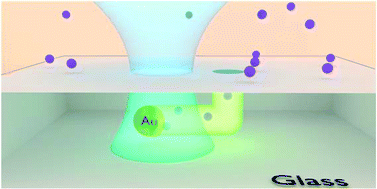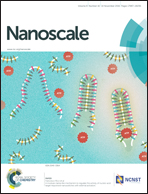Plasmonic-heating-induced nanofabrication on glass substrates†
Abstract
Fabricating nano-sized through-holes on a coverslip approximately 100 μm thick is challenging but rewarding when applied to ultrafine filters that separate proteins and DNA of various sizes and isolate viruses from cells. Toward this end, we developed an in situ etching-assisted laser processing technique exploiting gold nanoparticles. Plasmonic heating of a single gold nanoparticle through focused illumination of a continuous-wave laser beam enables structural modifications to be localized to the contact area on the glass surface. This results in the embedding of the particle forming nanocavities caused by chemical etching with aqueous tetrabutylammonium hydroxide. Depending on the shape of the nanoparticle, a highly flexible face geometry design such as a disk and triangle was achieved. The etching was monitored in situ through measurements of spectral red shifts in single-particle scattering, indicating an increasing medium refractive index consistent with embedding. The embedding process is unexpectedly fast, at 0.8 μm with 5 minutes of illumination. Besides nanoholes, we fabricated nanodomes around a single gold nanoparticle supported on a glass substrate through laser-heating-induced encapsulation. Overall, we were able to demonstrate true nano-laser processing free from diffraction-limited optics, with potential benefits of simple low-cost fabrication.



 Please wait while we load your content...
Please wait while we load your content...